【Final】Trump's 2024 Landslide: A Historic Upset That Redefined American Politics
Nov 17, 2024
Bill W. - In an election that shattered predictions and stunned the world, Donald Trump and the Republican Party achieved a sweeping victory, reshaping the political landscape and leaving an indelible mark on U.S. history.

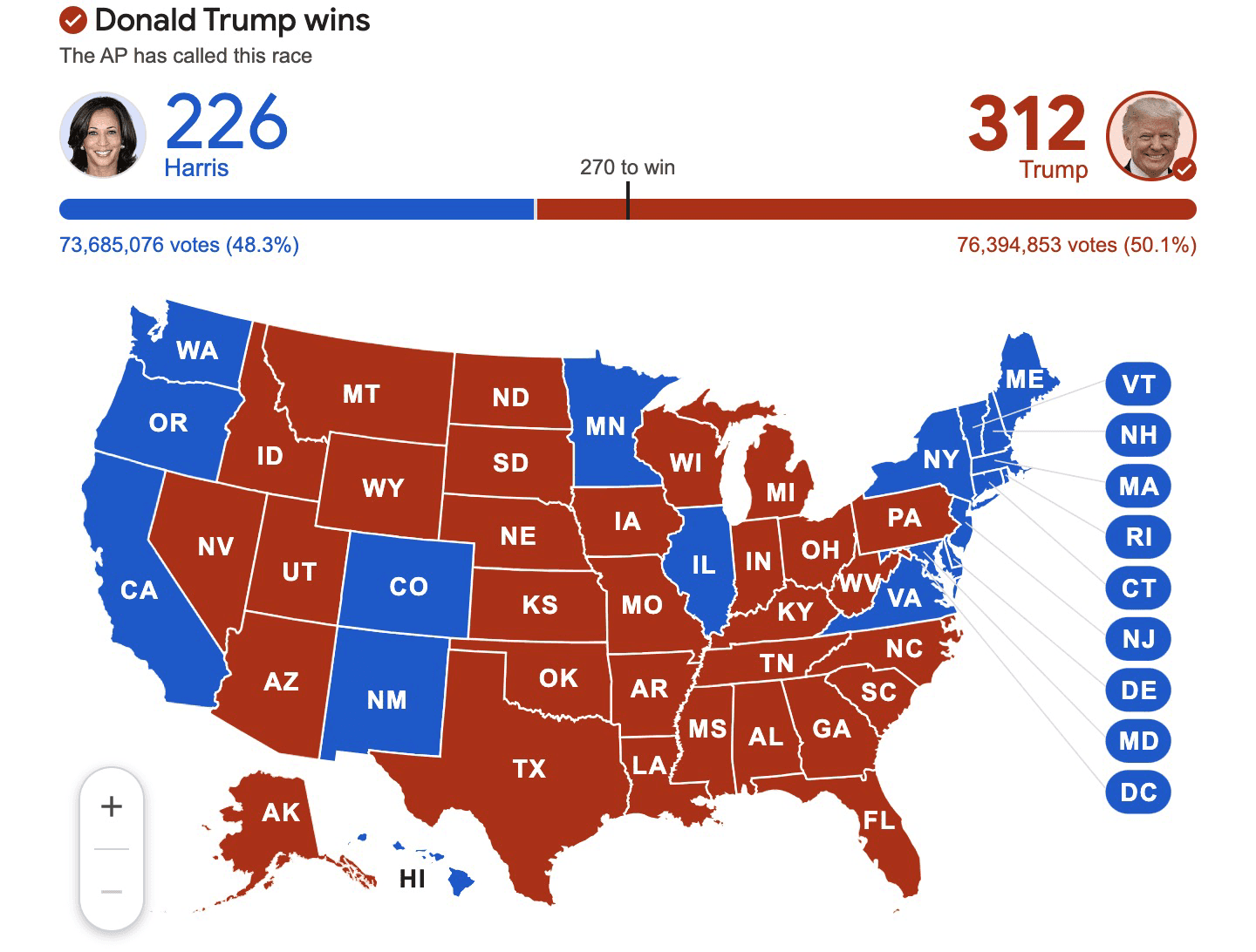
Victory, a sweeping landslide victory.
In the recently concluded U.S. presidential election, Donald Trump and the Republican Party achieved a historic triumph, securing the popular vote, the Electoral College, the Senate, and the House of Representatives. Trump also set a personal record, garnering over 76 million votes—a new high in his career. This outcome defied nearly all predictions from election experts, media outlets, pollsters, and even betting odds, which adjusted slightly in Harris’s favor at the eleventh hour. Yet, the result went entirely against mainstream expectations. However, on October 25, two weeks before the election, I accurately predicted the full Electoral College outcome: Trump would sweep all swing states and win 312 to 226. (For details, see: https://www.mysvbr.com/articles/2024-u-s-presidential-election-final-forecast-update-as-of-october-25). My prediction stemmed from sensing strong support for Trump and deep disappointment in the Biden-Harris administration’s economic policies among swing state voters and moderates.
As Bill Clinton famously stated during his campaign against George H. W. Bush, "It’s the economy, stupid." For moderates and independents, economic issues are always paramount. The Biden-Harris administration, however, failed to meet public expectations in this area. While the current wave of inflation in the U.S. cannot be entirely blamed on the administration, the public undeniably felt that inflation spiraled out of control during their term.
To be fair, the Biden administration demonstrated the qualities of a traditional American establishment politician, with a keen understanding of global dynamics. Despite the occurrences of the Russia-Ukraine war and the Israel-Palestine conflict under his watch, Biden's efforts to repair relationships with traditional European allies and counter China's influence in the Indo-Pacific region showcased his sharp geopolitical insight, even at 80 years old. Unfortunately, he seemed born into the wrong era—and his age certainly became a disadvantage. Beyond public misunderstanding, it is the Democratic Party elite who arguably owe him an apology. Their lack of respect for the sitting president pushed him into an oppositional stance. From endorsing Kamala Harris alongside him during the campaign to continuously undermining his position, these actions alienated him and indirectly fueled Trump’s monumental victory.
Returning to election night, I followed the results from the start of the count at 7 PM until Trump’s victory speech before going to bed. Even as several states remained undecided, I was confident Trump would win all the swing states. This article will break down the election into six sections: an analysis of swing states, the three new solid red states, why the data supports this outcome, the Senate and House races, a review of rewards and challenges for the midterms, and predictions for the 2028 election.
Analysis of Swing States
The swing states in the 2024 election were Georgia, North Carolina, Arizona, Wisconsin, Nevada, Pennsylvania, and Michigan.
Georgia and North Carolina: Subtle Shifts in Red Strongholds
The vote counts in Georgia and North Carolina followed a relatively predictable pattern, with Trump maintaining a slight lead once a significant number of votes were tallied. Both states, traditionally red, have been trending blue due to rapid urbanization and an influx of new residents. While Trump managed to secure victories in these states, the margins were narrower than in 2016. In Georgia, he won by 2.2% compared to 5.09% in 2016, and in North Carolina, by 3.36% compared to 3.66%. With continued population shifts, these states are likely to remain key battlegrounds for both parties in 2028.
Arizona and Nevada: The Sun Belt’s Red Momentum
Arizona and Nevada had notably slow vote counts, but seeing Texas’s results early on, I was confident these states would also lean toward Trump with relatively strong margins. The Sun Belt, particularly states along the Mexican border, was significantly influenced by dissatisfaction with the Harris administration’s handling of border security and immigration. Trump capitalized on these sentiments, winning Arizona by 5.51% (up from 3.5% in 2016). The only notable exception was Pima County near the Mexican border, where Harris slightly increased her lead from 13.8% to 15.2%.
Nevada was a significant breakthrough for Trump. Having lost the state by 2.42% in 2016 and 2.39% in 2020, he won it this year by 3.12%. With ongoing crackdowns on illegal immigration and further restrictive policies, both Arizona and Nevada are expected to continue trending Republican in future elections.
The Northern Trio: Blue Wall or Red Surge?
The northern trio of Wisconsin, Michigan, and Pennsylvania proved tricky. Once the cornerstone of the "Blue Wall," these states turned red for Trump in 2016 for the first time since 1992. In 2024, he flipped all three again with even larger margins: Wisconsin by 0.87%, Michigan by 1.41%, and Pennsylvania by 2.1%. These results highlight a broader red-shifting trend, similar to Ohio, as deindustrialization makes Trump’s protectionist policies increasingly appealing.
Wisconsin’s vote count remained evenly paced, with Trump maintaining a narrow lead throughout. Michigan and Pennsylvania, however, presented a more suspenseful scenario. Trump led in both states, but the slow reporting from key urban counties—Wayne County (Detroit) in Michigan and Philadelphia in Pennsylvania—kept his victories uncertain for much of the night. For example, when most rural counties were fully reported, Wayne County had only counted about 30% of its votes. However, Harris’s narrowing advantages in blue counties and her expanding disadvantages in red counties ultimately preserved Trump’s lead in both states.
Interestingly, Wisconsin’s margin of victory has been below 1% in the last three elections. Whether this trend will continue remains to be seen.
Overall Trends
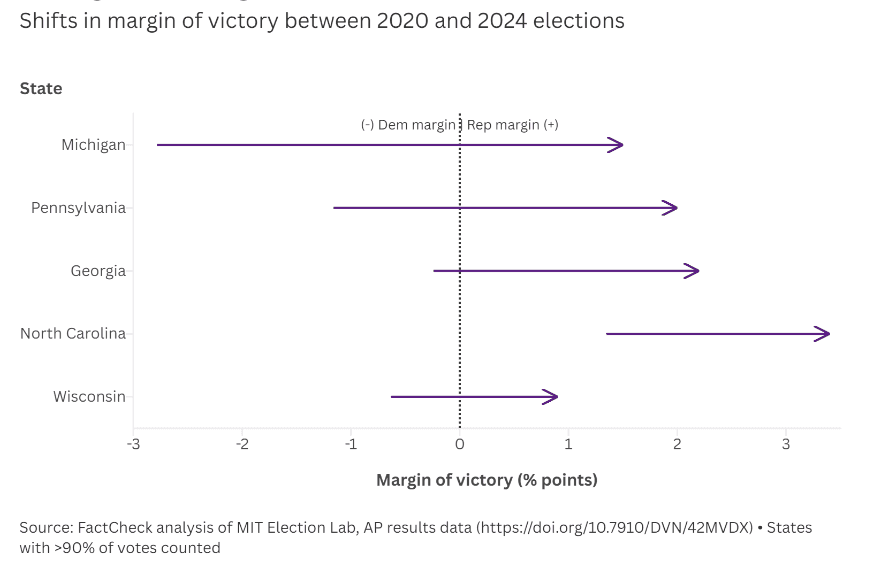
In summary, the current swing states show contrasting trends. The northern trio (Wisconsin, Michigan, Pennsylvania) and Arizona and Nevada are shifting red, while Georgia and North Carolina are trending blue. This dynamic gives the Republican Party a 61-32 Electoral College advantage across these seven states.
Looking Ahead
For the next election, Arizona and Nevada are likely to accelerate their red shift. The northern trio will depend heavily on how both parties engage in the region, given the Democratic Party’s traditionally deep roots in the Rust Belt—roots that appear increasingly fragile, as evidenced by the recent losses of incumbent Democratic senators in Ohio and Pennsylvania.
In North Carolina and Georgia, the Democrats will need significant grassroots mobilization to flip these states, especially North Carolina, a swing state Republicans have held since 2012. The GOP’s challenge lies in its relatively weak ground game in these states. Trump-backed candidates, while benefiting from his coattails, often fail to inspire independent support, potentially leading to scenarios where Trump wins at the presidential level while Republican candidates underperform down-ballot.
Trump’s margins of victory in these states are often his own, minus a small percentage—indicative of the difficulty Republicans face in translating his personal popularity into broader electoral success.
The Three New Solid Red States
There was once a saying: “Whoever wins Ohio wins the presidency.” However, with Ohio’s decisive shift to the Republican side in 2020, this rule no longer applies. Alongside Ohio, Iowa also turned red during the same election. This year, the trio of Ohio, Texas, and Florida—once widely regarded as "unstable red states"—has sent a clear message: "Oh, we are the Three New Solid Red States."
In the foreseeable short to medium term, Texas is expected to remain firmly Republican, while Florida and Ohio will continue their redward trajectory, telling the story of economically prosperous regions supporting the GOP.
From a data perspective, Trump’s margins of victory in Ohio have consistently increased over the last three presidential elections: 8.07% in 2016, 8.03% in 2020, and 11.35% in 2024, signaling a steady red shift. In Texas, Trump reversed the blue trend, winning by 8.99% in 2016, 5.58% in 2020, and a commanding 13.83% in 2024. Florida’s transformation is the most dramatic, with Trump’s margins growing from 1.2% in 2016 to 3.36% in 2020 and a staggering 13.11% in 2024. Natural disasters, golf culture, and Governor DeSantis’s influence deserve some credit for Florida’s shift, making it one of the few states where Trump achieved greater success in 2020.
Why This Happened

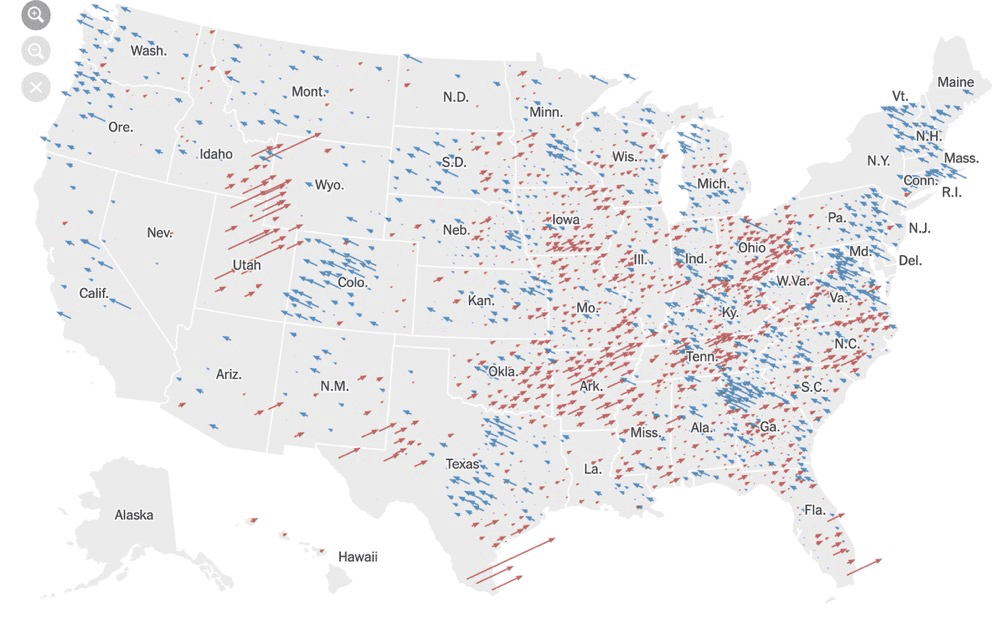

By analyzing the shift in margins between the elections, it becomes evident that both 2016 and 2024 were significant red waves, while 2020 was more divided. The most striking difference between the red waves of 2016 and 2024 lies in the GOP’s vastly increased influence in the South (notably in the border states with Mexico). Although not shown in some visuals, the trend is consistent across the entire South, including even parts of California. The Biden-Harris administration’s mishandling of natural disasters and the GOP’s relentless focus on immigration issues over the past four years have played a significant role in this outcome.
Strategic Implications
These three states demonstrate that Trump and the GOP have successfully solidified their stronghold. The next steps will follow a three-pronged strategy:
Deepen support along the western border (Nevada, Arizona).
Stabilize the eastern coastal swing states (North Carolina, Georgia).
Concentrate efforts on flipping the Blue Wall (Wisconsin, Michigan, Pennsylvania).
This strategic approach aims to expand on the GOP’s growing dominance while targeting key swing regions to secure future victories.
Why the Data Supports This Outcome
Data is always the best teacher, and the various data points from this year’s election speak volumes.
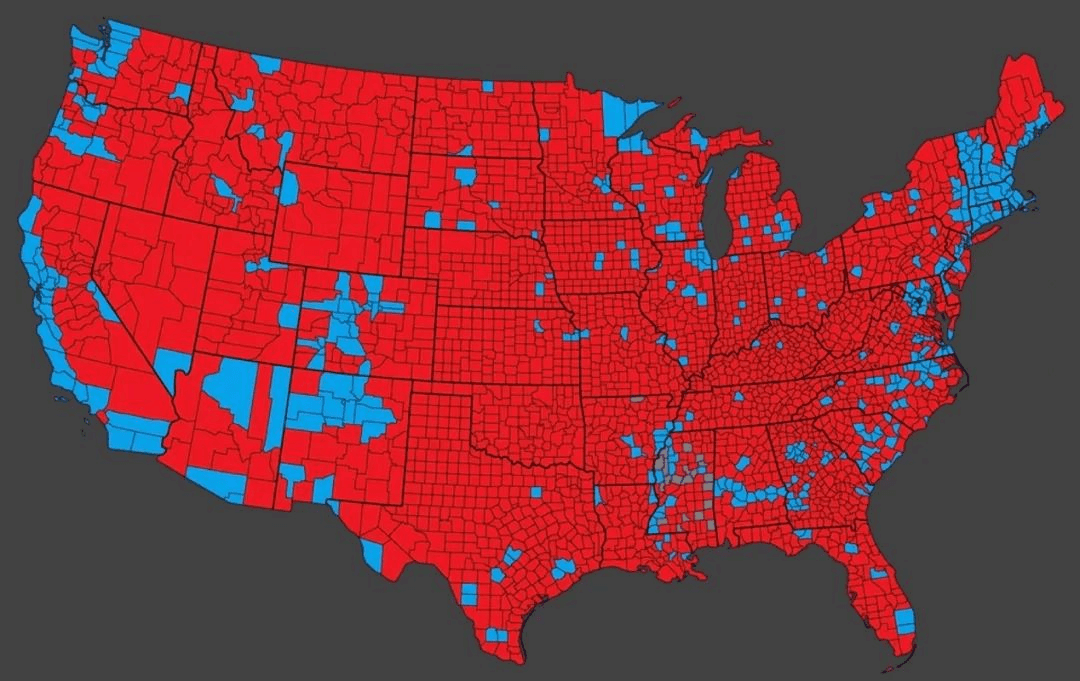
First, let’s look at the county-level election map. In Mao Zedong’s communist revolution, there was a theory called “encircling the cities from the countryside.” When viewing the vast expanse of red on this map, it’s hard not to draw parallels to the “MAGA revolution.”
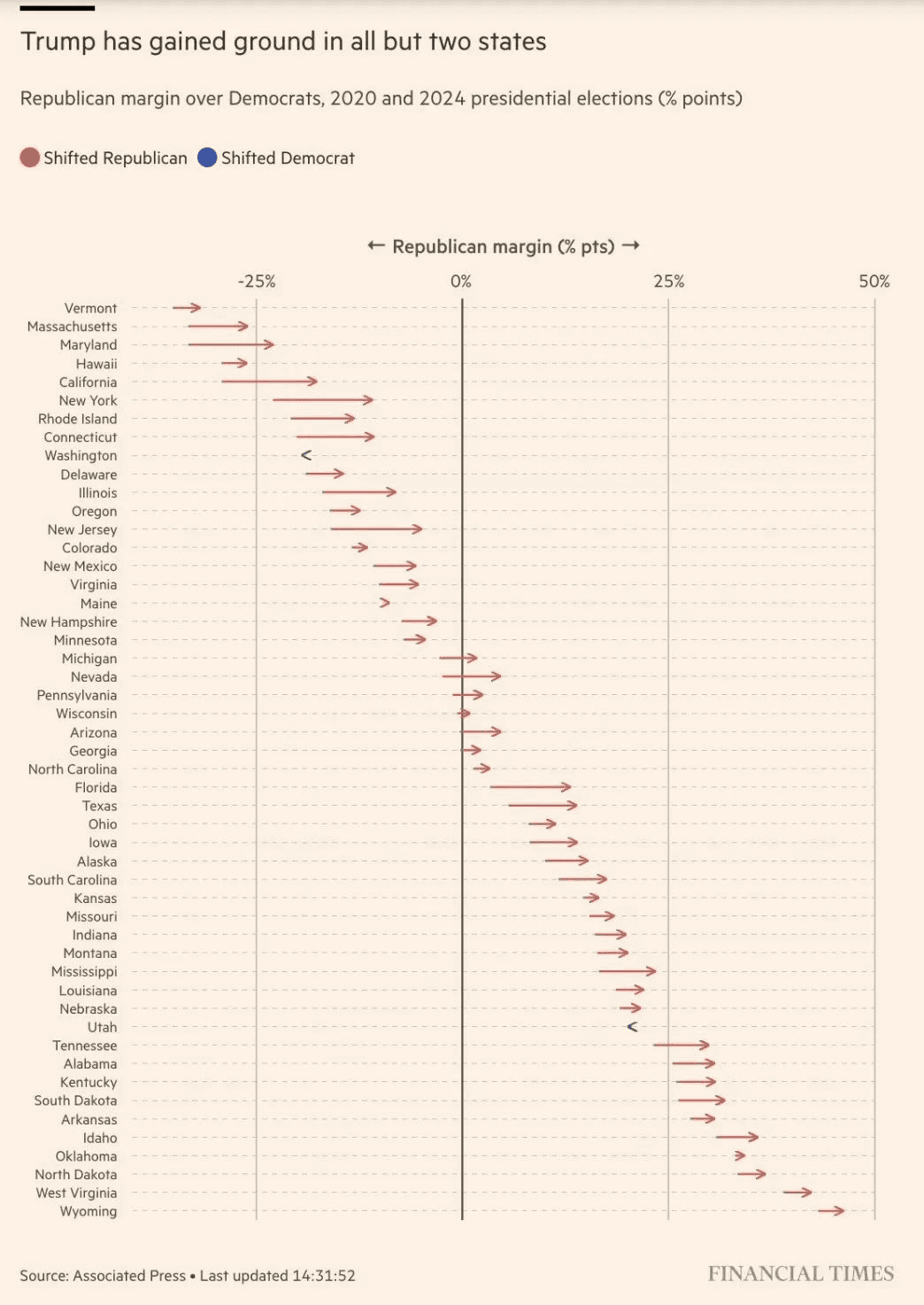
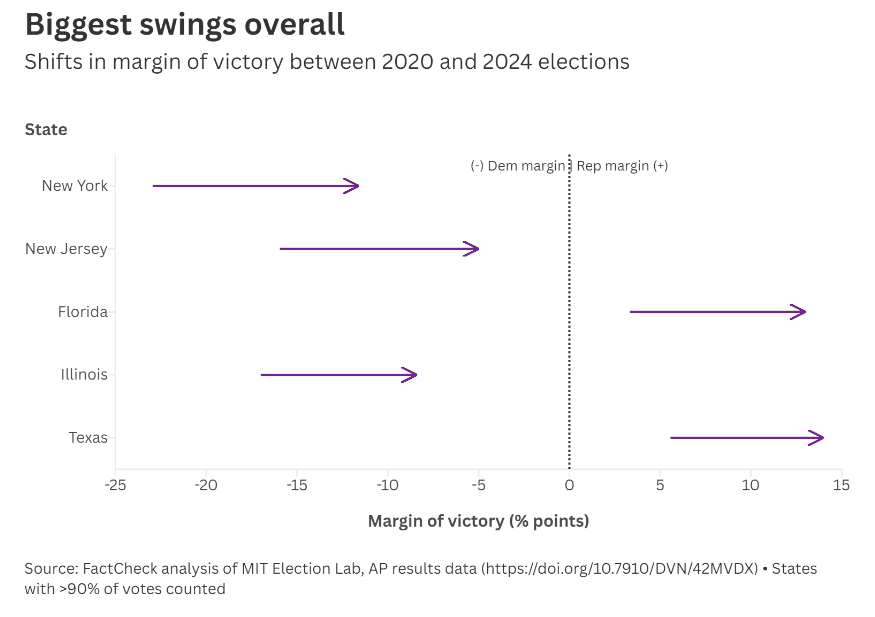
The second and third charts shows that, compared to 2020, only Utah and Washington shifted slightly more Democratic, while all other states moved further to the right. Among these, several states exhibited the most significant red shifts: California (surprisingly), New York, Connecticut, New Jersey, Illinois, and the previously mentioned Texas and Florida.
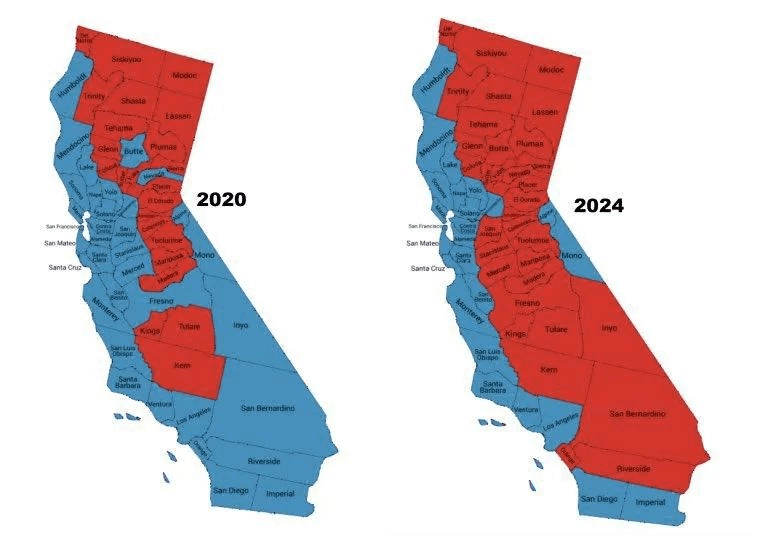
The first group includes traditionally deep-blue states, particularly California, which is also Harris’s home state. From the data, Clinton and Biden both led Trump by about 30% in California during the 2016 and 2020 elections. However, this year, Trump trailed by only 20%, meaning Harris lost approximately 2 million votes in her home state.
Similarly, in New York, Trump’s second home state, he lost by roughly 23% in both 2016 and 2020. This year, the gap narrowed significantly to just 12%. Other notable blue states where Trump made gains include New Jersey, New Mexico, and Virginia, where his deficits shrank to under 6%. This shift positions these three states, along with Minnesota and New Hampshire, as potential swing states in 2028 and beyond.
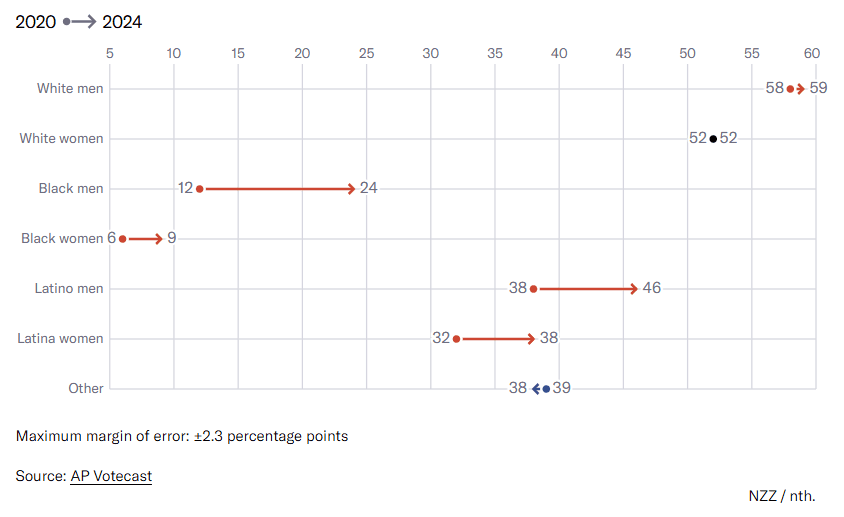
The fifth chart illustrates that Trump’s support increased across nearly all demographic groups. According to the data, Trump maintained a 6% lead over Harris among white women. Despite being portrayed as a major antagonist to women’s rights, Trump still garnered the majority of white women’s support, while also increasing his support among Black women and Latina women by 3% and 6%, respectively.
I believe many women who voted for Trump still support abortion rights. This suggests that either they prioritized other issues over abortion or they did not believe Trump would significantly impact their access to abortion rights. In fact, Trump has consistently stated that he prefers to leave the issue of abortion to state-level referendums, allowing the people in each state to decide.
That said, the MAGA faction does include many absolute pro-life advocates, which has indirectly contributed to Trump’s negative public image on abortion rights. However, it is clear this perception did not substantially affect Trump’s ability to attract votes.
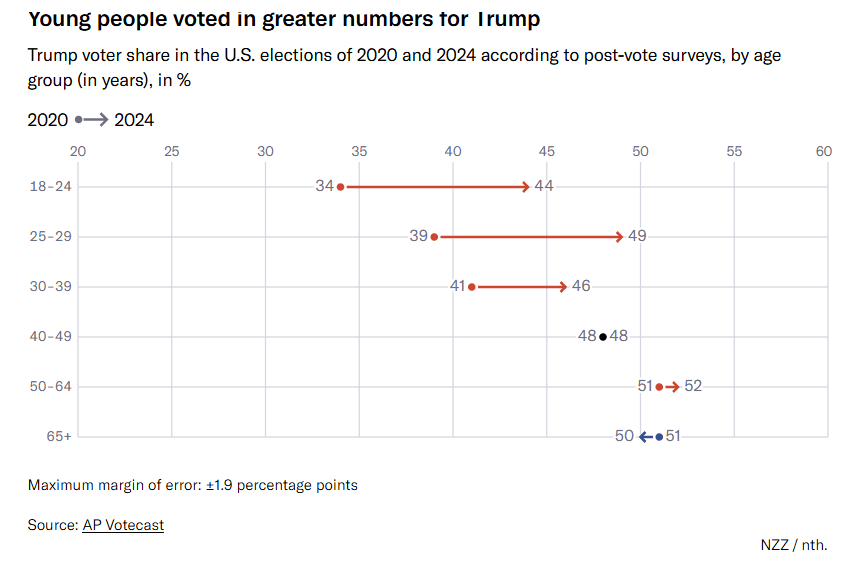
Trump also gained significant support among voters under 40, which aligns closely with my personal observations.
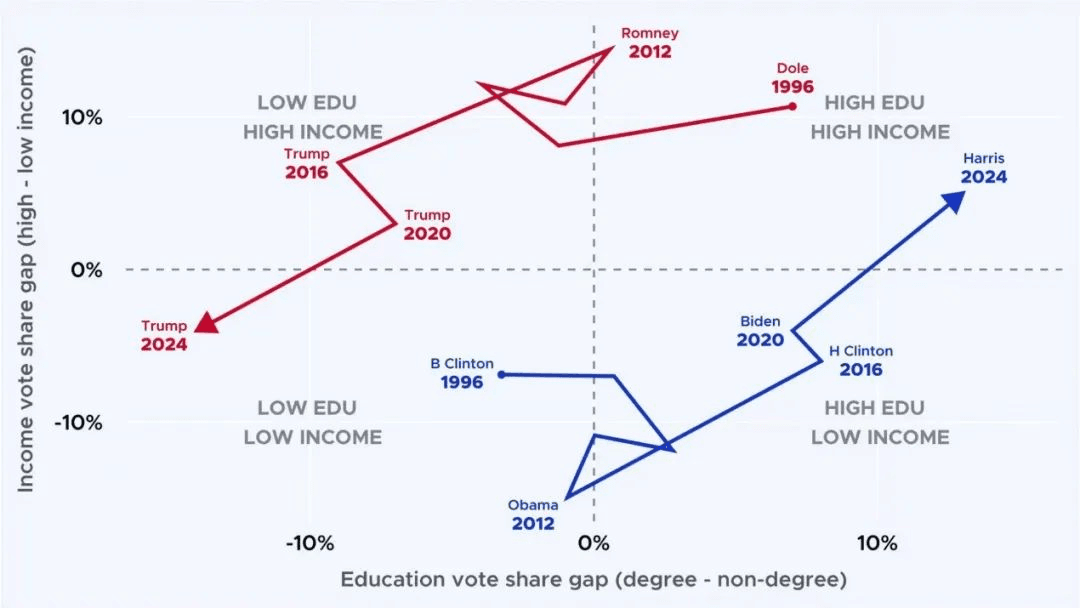
In terms of voter demographics, since 1996, the Republican and Democratic parties have experienced a reversal in their voter profiles. In 1996, Republican supporters were characterized by high education levels and high incomes, while today they are more associated with lower education levels and lower incomes. Conversely, Democratic supporters now fit the former Republican profile.
This shift aligns with the MAGA movement and the strong support Trump has garnered from working-class and middle-class voters, as well as the consistent protectionist policies central to the MAGA agenda.
The Senate and House Races
In this section, I will analyze several key Senate races and make predictions for the House results, while also providing insights into a few elections of personal interest.
Senate Races
The Senate results largely aligned with polling expectations, with two significant upsets in Ohio and Pennsylvania.
In Ohio, incumbent Democratic "blue dog" Senator Sherrod Brown, a centrist, was defeated by far-right MAGA candidate Bernie Moreno. Most polls predicted a win for Brown, or at worst, a narrow Moreno victory, but Moreno ended up winning by 3.8%, unseating Brown after nearly 18 years in office. Although Moreno’s votes lagged Trump’s Ohio tally by 7.55%, his victory was remarkable for a political newcomer running as a far-right candidate with weak fundraising. Despite being inundated with anti-Moreno ads on platforms like YouTube, he managed to secure the seat.
Pennsylvania also saw a Republican upset. Although David McCormick only won by a narrow margin, it defied the expectations of most polls. The Trump-McCormick margin was just 1.9%, demonstrating McCormick’s competence. His opponent, Casey Jr., like Brown in Ohio, was a long-standing incumbent with 17 years of experience. This win was a valuable one, solidifying the Senate’s composition at 53 Republicans and 47 Democrats.
Other Senate races in swing states highlighted the Democratic Party’s strong grassroots foundation and fundraising capabilities. However, Michigan and Wisconsin races were decided by margins of less than 1%, reflecting the consistent voting patterns of Blue Wall states, where Senate and presidential election results show minimal divergence. In Arizona, the gap between the presidential and Senate results exceeded 7.8%, mirroring trends seen in Ohio. Like Moreno, Arizona’s Republican Senate candidate Kari Lake, also a far-right MAGA figure, struggled. Trump’s weaker support in Arizona compared to Ohio contributed to Lake’s loss, which was not unexpected.
House Races
For the House, I predict the final results will be either 221 Republicans to 214 Democrats or 222 Republicans to 213 Democrats. In ongoing races, Republicans are likely to win Alaska At-Large, California 13, and Iowa 1, while Democrats are expected to secure California 27 and Ohio 9, leaving California 45 as a toss-up.
Currently, the margins in California 45, Iowa 1, and Ohio 9 are all within 0.3%, making them extremely difficult to call. However, since all three races feature incumbent candidates, I lean toward believing these incumbents will retain their seats.
Iowa 1: Miller-Meeks won her 2020 election in the same district by just 6 votes. This year, she leads by 801 votes with over 99% of votes counted, making her likely to secure this seat.
Ohio 9: Democratic incumbent Kaptur has represented this district for over 40 years. This has been her toughest race yet, winning less than 50% of the vote and leading her Republican opponent by just 0.3%. Previously, she had won by margins exceeding 10%, but Ohio’s red shift has significantly tightened this race. With over 99% of the votes counted, I believe she will narrowly retain her seat.
California 45: This district is the hardest to predict. Steel, a Republican, has held the seat for the past few elections. Although her Democratic opponent Tran briefly led by 36 votes, Trump’s strong performance in California this year makes this a true toss-up district.
Elections of Personal Interest
Two additional districts of personal interest are Ohio 13 and New Hampshire 2.
Ohio 13: Democratic incumbent Sykes has strong local support and decent fundraising capabilities. She is a relatively centrist Democrat, but Ohio’s redward trend made this year’s election a tough battle. She ultimately won by 2%. As Ohio continues to shift red, I believe Ohio 9 will flip Republican soon, and Ohio 13 will likely follow suit, turning red as early as 2026.
New Hampshire 2: This district gained national attention after Tang Williams, a first-generation Chinese immigrant, harshly criticized Goodlander, the wife of the National Security Advisor, during a debate. The election results show that the Democratic lead in this district dropped from 11.7% in 2022 to 5.7% this year. Whether this district will flip red in the future remains uncertain, but it is worth monitoring.
A Review of Rewards and Challenges for the Midterms
Since the Civil War, there have been 41 midterm elections, and only five times has the incumbent party gained seats in the House of Representatives: in 1866, 1902, 1934, 1998, and 2002. Moreover, there have only been three instances where the incumbent party retained its majority in the House.
In the Senate, the situation is less precarious for the GOP, as they are unlikely to lose their majority and may even gain a few seats. However, in the House, the Republicans' slim majority—fewer than 10 seats—could pose challenges. This is why Trump will need to accelerate the implementation of many political initiatives during the first two years of his term.
Key figures in Trump’s proposed cabinet include Secretary of State Marco Rubio, Attorney General Matt Gaetz, Secretary of Health and Human Services RFK Jr., Ambassador to the United Nations Elise Stefanik, Director of National Intelligence Tulsi Gabbard, National Security Advisor Mike Waltz, and a joint leadership of Elon Musk and Vivek Ramaswamy for the Department of Government Efficiency.
This group features members of the “New Florida Crew,” individuals who flipped during the election, and prominent business leaders who publicly supported Trump. Other cabinet members are expected to be staunch loyalists. It is clear that Trump’s second cabinet will be much more obedient than his first. Rubio, Waltz, and Stefanik are all China hawks, which aligns well with Trump’s foreign policy agenda.
This cabinet lineup reflects Trump’s desire for swift action on government initiatives and continues to highlight his tendency to favor loyalty above all else when selecting personnel.
Predictions for the 2028 Election
Black swan events are inherently unpredictable, but overall, I am confident that the Republican Party will secure another four years in 2028. Trump’s victory in this election has finally completed the restructuring of the GOP. While it wasn’t the anti-establishment defeating the establishment as many hoped, it was instead the new establishment overtaking the old.
This Republican Party remains unstable, with potential for significant internal conflicts. However, one thing is certain: the GOP has successfully built its leadership pipeline, elevating a new generation of young leaders to positions of importance.
From the perspective of the 2028 election, J.D. Vance clearly leads the race for the Republican presidential nomination. His eloquence and sharp thinking are unmatched nationally. His primary challenge over the next four years will be avoiding the pitfalls that befell Harris. DeSantis and Haley might still try to challenge him, but their chances are slim, and it is unlikely that Vance would choose either of them as his running mate. Many members of Trump’s current cabinet could become potential VP candidates, though it is too early to speculate.
On the Democratic side, Harris’s political career is effectively over. The Democrats seem to have realized that an extreme left-wing candidate will not yield favorable results. This dims the prospects of party stars like California Governor Gavin Newsom and Transportation Secretary Pete Buttigieg—even if they win the primaries, their general election prospects look bleak. The same applies to Sanders’s successor, AOC.
Michigan Governor Gretchen Whitmer would be a strong VP candidate, but after two consecutive defeats with female candidates, it is uncertain whether the Democratic Party will choose another woman. One exception, however, is Michelle Obama. As a representative of one major faction of the Democratic establishment, she could leverage Barack Obama’s legacy to run.
That said, I believe the Democrats’ best choice isn’t Michelle Obama but Pennsylvania Governor Josh Shapiro. His traditional political stance and high approval ratings make him an excellent candidate. If the Obama faction refrains from backing the former First Lady, Shapiro is likely the one candidate who could unite both the establishment and the progressive wings of the party—something Michelle might not be able to achieve.
It’s too early to predict the outcome of the 2028 election, but as things stand, a Vance vs. Shapiro contest might provide the most competitive matchup.
Conclusion
The 2024 election has concluded. While reflection is important, the most crucial thing is to leave hatred behind and move forward. The beauty of politics lies in its unpredictability—just as no one a decade ago could have predicted the profound impact Trump would have on American society and politics today.
Regardless of whom you supported, the election is over. I hope everyone can find joy and happiness without letting the outcome of the election overshadow their lives.